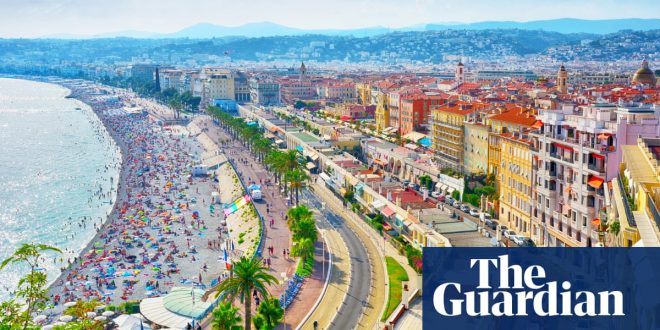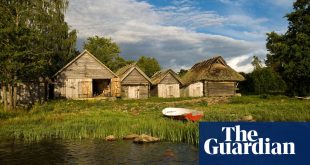The Tour de France ends in Nice this Sunday – the first time the race will finish outside Paris since it started in 1903, and the first time since 1989 that the winner’s yellow jersey will be decided by a final-day time trial.
The Tour’s arrival in Nice also coincides with the 200th anniversary of the city’s Promenade des Anglais, the seafront walkway partly funded by English chaplain Lewis Way. The rest of the work on the paved Camin dei Ingles, as it was originally known, was paid for by Way’s congregation, and the first section was finished in 1824. Two hundred years on, I’m cycling along the rosé-coloured promenade with my dog Rio in the front basket, his ears fluttering in the sea breeze as we head for the Plage des Chiens, halfway to the airport.
The Tour de France riders will be on the same route, except they’ll be cycling contre la montre so won’t get much chance to appreciate Europe’s greatest seafront highway. Nor the belle époque masterpieces as they surge round the Rauba Capeu headland (“hat stealer” in Niçois, after the fierce winds) past the pastel-painted cottages of the Quai des États-Unis before sprinting down the Promenade des Anglais.
First on my right is the Jardin Albert 1er, whose bandstand dates from 1860, the year Nice joined France from the Kingdom of Savoy and Sardinia. Heading west I pass the white granite art deco facade of the Palais de la Méditerranée, built by American billionaire Frank Jay Gould in 1929. It’s followed by a line of seafront hotels – the Royal, the Westminster and the West End – before the sumptuous Villa Masséna, with its collection of Napoleonic memorabilia and tropical gardens.
Riders will sprint past Le Negresco hotel, which opened in 1913, a belle époque palace in meringue white with a glass-domed ballroom whose doorman still wear red knickerbockers, blue jackets and plumed hats. The Negresco was a popular haunt for Salvador Dalí, Pablo Picasso and Louis Armstrong; Elizabeth Taylor and Richard Burton stayed there; and the Beatles waved from its balcony when they came to Nice in June 1965. It was also a favourite of dancer Isadora Duncan, who had a dance studio round the corner and died right here on the promenade when her long silk scarf caught in the wheel of her sports car. A few villas down, No 54 was the home of Emil Jellinek, who named his car company, Mercedes, after his daughter. Today it’s the Mercedes apartment block, rebuilt like its neighbours in the 1930s and 40s with art deco extensions and marine-themed ironwork balconies.
On the beach to my left the nautical style continues, with striped parasols, flagpoles, white benches and sea-blue chairs, one row looks out to sea and the other faces the rollerbladers, cyclists and boulevardiers strolling along la Prom.
Most of the scores of opulent villas that once overlooked the beach here have been demolished and replaced by apartment buildings. One that still stands is the neoclassical Villa Furtado-Heine. Built between 1784 and 1787, it was once home to Napoleon’s sister Pauline, and is now a home for war veterans, hidden behind a garden of fig trees, cacti and jacaranda.
A block further west is the Centre Universitaire Méditerranéen, a smart cream and terracotta building with white marble steps and a huge auditorium which became a centre for intellectual and cultural exchange in 1933. This season’s lectures include “The Love Language of Albert Camus” and “Shostakovich and Stalinian Censorship”.
The Tour de France riders will do a 180-degree turn here to head back along the promenade and finish in Place Masséna, but my journey to the dog beach continues for another few kilometres. Past the lines of palm trees and the butterscotch-coloured villa of the Société Centrale d’Agriculture et d’Horticulture, built so local aristocrats could boast about the plants they’d brought back from overseas.
I pass apartment blocks called Bagatelle, L’Elisabeth, Le Margaret and Le Copacabana before reaching my favourite seafront properties, known as the non-identical twins: two next-door villas from very different periods. No 139, Villa Collin de Huovila, was finished in 1911 – an elaborate art nouveau masterpiece topped with a samurai helmet-style roof and decorated with cherubim throwing flowers at a nude caryatid. Next door is Villa Monada, built in white modernist blocks in the 1930s, a cubist mirror image of its eccentric neighbour. They are both still in private hands, but almost everything else along the promenade is flats or hotels.
In the late 19th century, pavilions were erected on the beach to allow hotel guests to change into their bathing suits. Carpets allowed them to walk across the pebbles unscathed and, since hardly anyone could swim, they climbed into barrels filled with warmed seawater. The promenade today has a two-way cycle lane, water fountains, bike repair stations and a wide walkway, now safeguarded by bollards and a white steel rope after the Nice terrorist attack in 2016 when 86 people were killed. A monument to them, L’Ange de la Baie by Jean-Marie Fondacaro, stands opposite the Palais de la Méditerranée.
Nice’s energy is on display along the 7km of the Promenade des Anglais. Firework displays, buskers, volleyball and boules courts, Ironmen, marathons and games of pilou all take place here. I cycle past hundreds of joggers, tourists gazing into their phones, flâneurs and grandparents pushing strollers as far as the dog beach, where Rio meets his posse.
When reporter Joseph Roth wrote about Nice for the Frankfurter Zeitung in 1925, he described the “old ladies, 10 years younger on facials and diets … adorned by unbelievably tiny lapdogs, talking about the future not the past, like other ladies elsewhere”. A century on, nothing has changed. Nice’s beaches at daybreak are full of elderly locals swimming in the calm sea, while their dogs, wrapped in the cashmere yellow jerseys they’ve left behind, wait patiently on the beach.
Eat at Le Galet, which serves salade niçoise, seafood, pasta and Mediterranean dishes on the beach
Stay at the West End, one of the giant belle-époque hotels on the seafront (doubles from €150)
 Top Naija News – Nigeria News, Nigerian News & Top Stories Top Naija News – Nigerian Newspapers, Nigerian News. topnaijanews is a daily Nigerian newspaper covering Latest News, Breaking News, Entertainment, Sports, Lifestyle and Politics.
Top Naija News – Nigeria News, Nigerian News & Top Stories Top Naija News – Nigerian Newspapers, Nigerian News. topnaijanews is a daily Nigerian newspaper covering Latest News, Breaking News, Entertainment, Sports, Lifestyle and Politics.




